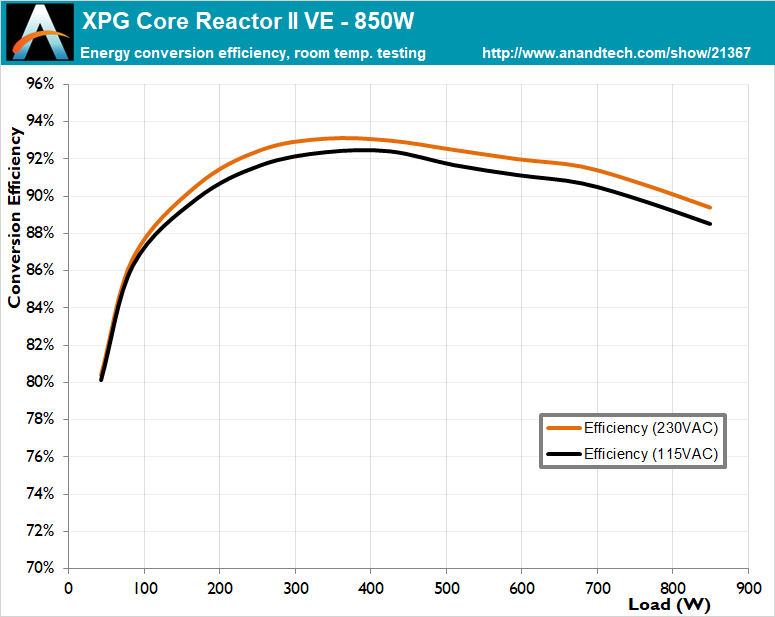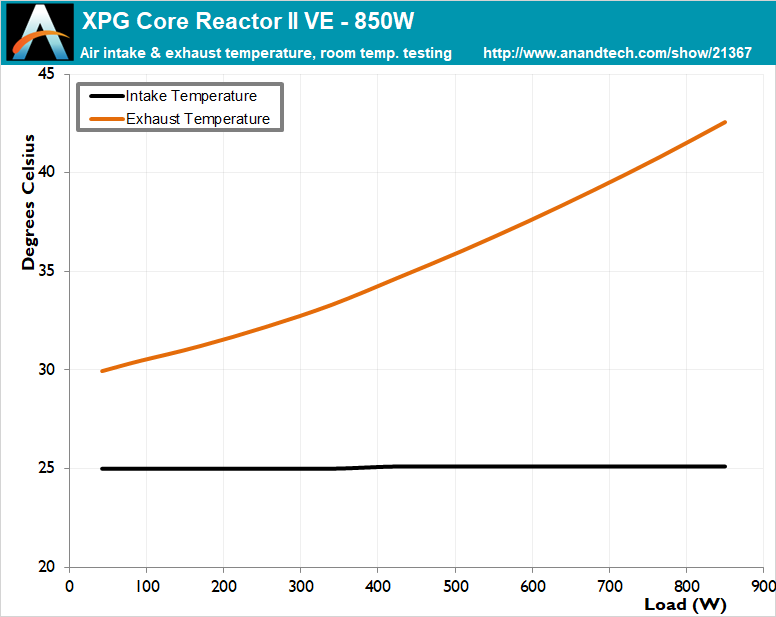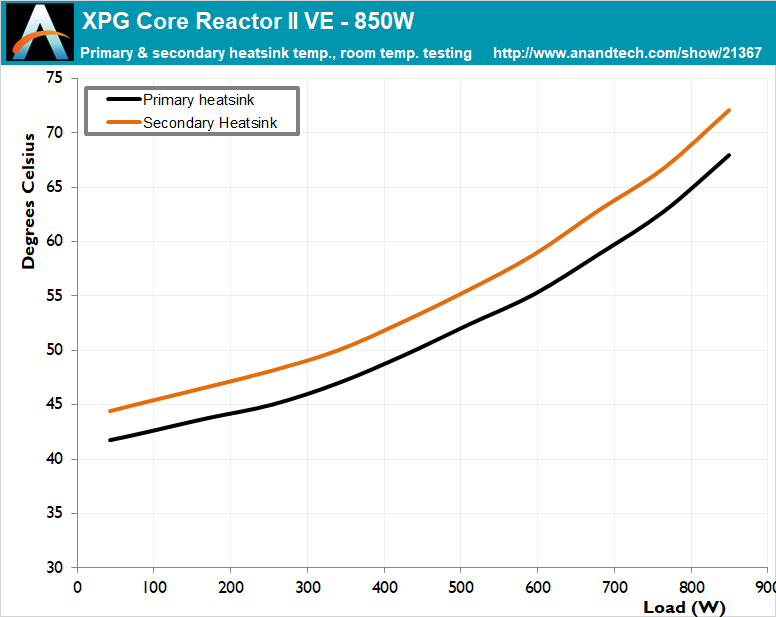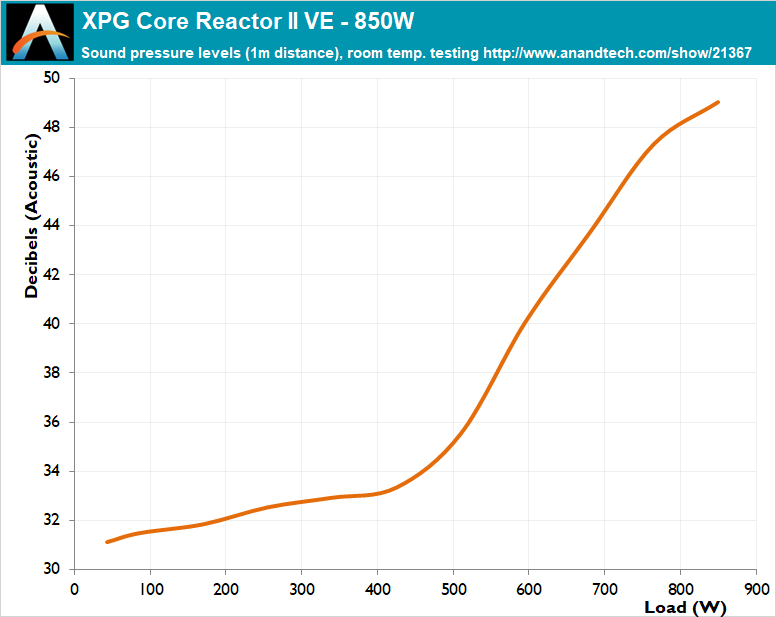The XPG Core Reactor II VE 850W PSU Review: Our First ATX 3.1 Power Supply
by E. Fylladitakis on May 2, 2024 10:00 AM EST- Posted in
- Cases/Cooling/PSUs
- PSUs
- 80Plus Gold
- XPG
- ATX v3.1
Cold Test Results (~25°C Ambient Temperature)
For the testing of PSUs, we are using high precision electronic loads with a maximum power draw of 2700 Watts, a Rigol DS5042M 40 MHz oscilloscope, an Extech 380803 power analyzer, two high precision UNI-T UT-325 digital thermometers, an Extech HD600 SPL meter, a self-designed hotbox and various other bits and parts. For a thorough explanation of our testing methodology and more details on our equipment, please refer to our How We Test PSUs - 2014 Pipeline post.
The XPG Core Reactor II VE 850W PSU surpasses the requirements set by the 80Plus Gold certification with impressive margins. When operating with a 115 VAC input, this PSU demonstrates an average nominal load efficiency of 90.9% across a range from 20% to 100% of its capacity, which further increases to 91.7% with a 230 VAC input. The efficiency peaks at a load slightly less than half its maximum capacity. Low load efficiency is excellent, notably superior to that of many other units with a similar power output.
The XPG Core Reactor II VE 850W PSU does not have a "hybrid" fan mode - its fan is operational at all times. Even in ambient room temperature, the fan operates continuously but at very low speeds while the load is low, gradually increasing its speed as the load escalates beyond 500 Watts. This simplistic approach reduces the complexity of the design a little and the PSU virtually remains inaudible while the load is very low.















31 Comments
View All Comments
Dante Verizon - Thursday, May 2, 2024 - link
These tests confirm what I always say: buy a PSU with 20% more power than recommended for your system.You'll have a safety margin, the PSU will work cooler, quieter and should even last longer
haukionkannel - Thursday, May 2, 2024 - link
So this is the first psu with somewhat fixed 12 pin power connectors. What gpus have now? These new connectors aka do we see improved safety from now on….Ryan Smith - Thursday, May 2, 2024 - link
GPUs have already started using the revised connector. PSUs take a bit longer to spin up, both because they don't sell through as quickly, and because there are material changes to power delivery in ATX 3.1 that had to be accounted for.Samus - Tuesday, May 7, 2024 - link
Are these HP12V connectors backwards compatible with one another between cards, cables and PSU's?flgt - Thursday, May 2, 2024 - link
I’m know it’s tough with all the legacy hardware, but they really need to go the 48 VDC at this point if they are writing new specs.Railgun - Thursday, May 2, 2024 - link
What?zodiacfml - Friday, May 3, 2024 - link
I like 48V but that would require change across the industry, like datacenters and more. Tesla is likely to go this route, they already announced a revolutionary datacenter years ago for efficiency.meacupla - Friday, May 3, 2024 - link
The thing is though, 48V isn't all that efficient due to CPU/GPU/DRAM etc. all wanting 1.1~1.5V.The larger the step is, the less efficient the conversion becomes.
Laptops have this all figured out already, and 19.5~20V has the best power efficiency.
USB-C PD allows up to 240W (48V, 5A), but no one has bothered to implement this on either end.
There are no laptops with 240W USB-C input, and no chargers that do 48V, 5A output. The only 240W PD parts out are cables.
The reason being the above mentioned efficiency loss when stepping down the input voltage.
Scabies - Friday, May 3, 2024 - link
Framework 16 allows 240W charging. Admittedly, their best GaN adapter tops out at 180W.zodiacfml - Saturday, May 4, 2024 - link
I think conversion losses is even or same for specific target chip voltages. Actually, many modern PSU designs steps up voltages from the power outlet to insane numbers so that losses and AC transformer size required is minizmied then step down the voltage through solid state components or DC converters.